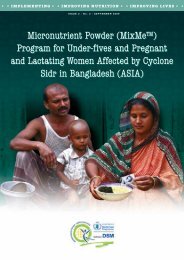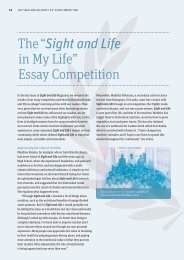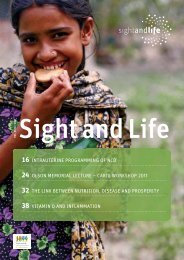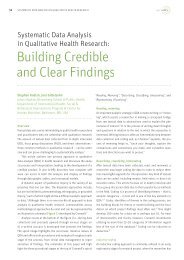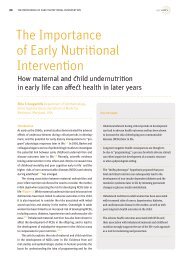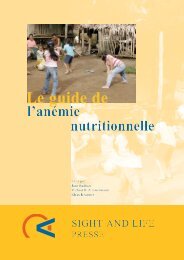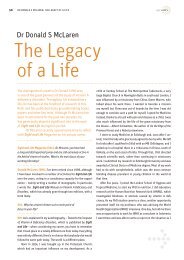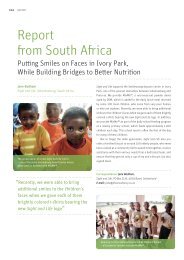Sight and Life Magazine 1/2011
Sight and Life Magazine 1/2011
Sight and Life Magazine 1/2011
You also want an ePaper? Increase the reach of your titles
YUMPU automatically turns print PDFs into web optimized ePapers that Google loves.
82 WHAT'S NEWEach Task Force is finalizing its specific terms of referenceas well as an action plan <strong>and</strong> many are doing this at the sametime as beginning to deliver on specific projects.<strong>Sight</strong> <strong>and</strong> <strong>Life</strong> is represented on Task Force B by Jane Badham.We will ensure that we give regular updates on the variousSUN activities, as its aim is to be transparent <strong>and</strong> include asmany stakeholders as possible.SUN is currently consolidating <strong>and</strong> building stakeholderalliances <strong>and</strong> aligning donor commitments with country-ledplans for improving nutrition. In a recent article by DavidPelletier et al, published in Health Policy <strong>and</strong> Planning(<strong>2011</strong>;1–13) <strong>and</strong> entitled “Nutrition agenda setting, policyformulation <strong>and</strong> implementation: lessons from the MainstreamingNutrition Initiative”, the authors highlight the realitythat we face. While undernutrition is the single largest contributorto the global burden of disease <strong>and</strong> can be addressedthrough a number of highly efficacious interventions, ingeneral it has not received commensurate attention in policyagendas at global <strong>and</strong> national levels. Implementing theseefficacious interventions at a national scale has also provendifficult. This is an important fact that has to be considered<strong>and</strong> overcome as SUN rolls out at a country level.setting, policy formulation, capacity building for operations,<strong>and</strong> all other aspects of a long-term nutrition agenda atcountry level.> These conclusions are especially relevant for major globalinitiatives currently under development that seek to addressnutrition through country-led processes <strong>and</strong> convergencebetween multiple organizations.> The extensive investments in documenting the efficacy ofnutrition interventions are unlikely to produce sustainablereductions in undernutrition unless or until these weaknessesin the policy spectrum are better understood <strong>and</strong>addressed.SUN <strong>and</strong> the 1,000 Days movement are the start of alarger movement that hopes to address these real globalnutrition issues by focusing attention, aligning <strong>and</strong> increasingresources, <strong>and</strong> building partnerships. The SUN must shineif nutrition is to take its rightful place <strong>and</strong> deliver to alleviatethe suffering caused by undernutrition among millions ofpeople around the world – especially pregnant women <strong>and</strong>children under two years of age.Key messages include:> Strengthening the full spectrum of policy activitiesis necessary if large-scale <strong>and</strong> sustained reductions inundernutrition are to be achieved.> Within this policy spectrum, high priority should be givento strengthening strategic capacities because these arefundamental to advancing commitment building, agendaComing soon will be a SUN websitewatch for the link from www.sight<strong>and</strong>life.orgnd <strong>Life</strong> <strong>and</strong> Vitamin AngelsImproving Lives in India03er<strong>Sight</strong> <strong>and</strong> <strong>Life</strong> <strong>and</strong> the non-profit organization Vitamin Angels, live in India, making addressing vitamin A deficiency inwhose mission is to mobilize <strong>and</strong> deploy private sector resourcesto advance availability, access <strong>and</strong> use of vitamin A micronutrient deficiencies. While the Government of IndiaIndia a critical component of the global challenge to eliminateby newborns, infants <strong>and</strong> children most in need, have recentlysigned a Memor<strong>and</strong>um of Underst<strong>and</strong>ing. The partnership a large proportion of infants, children <strong>and</strong> lactating womenfully supports initiatives for vitamin A supplementation <strong>and</strong>will work together to build on their individual strengths to receive supplementation, there remains a significant portionfoster local ownership of the problem of vitamin A deficiency of the population that has yet to be reached.in India, <strong>and</strong> catalyze a locally sustainable supply <strong>and</strong> distributionsystem in India.technical expertise <strong>and</strong> Vitamin Angels’ successful implemen-“Through this partnership, <strong>Sight</strong> <strong>and</strong> <strong>Life</strong>’s advocacy <strong>and</strong>Fifty-one percent of the 190 million children under five tation of universal vitamin A supplementation projects aimwho suffer from moderate <strong>and</strong> severe vitamin A deficiency to reach millions of those in India who have to date not



